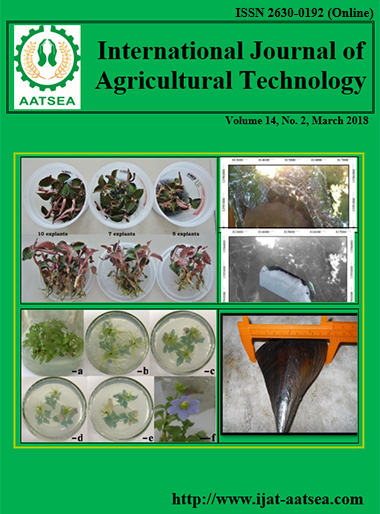Commercial Feed and Algae for Feeding Pinna bicolor in Indoor Tanks
Main Article Content
Abstract
The research determined the growth rate and survival rate of Pinna bicolor fed with commercial feed mixed with algae in three different proportions under the indoor condition. Pinna bicolor with the size more than 13 cm. length were caught from the natural in Chonburi province and were acclimatized in the concrete pond for 10 days. 30-33 ppt. of seawater was used in the experiment. After acclimatization, P. bicolor were divided into 3 treatments with 3 replications. Treatment 1 was fed with 0.5 g. of commercial feed and 1 liter of mixed Isochrysis sp. + Tetraselmis sp. in 25-liter indoor tank. Treatment 2 was fed with 1.0 g. of commercial feed and 1 liter of mixed Isochrysis sp. + Tetraselmis sp. Treatment 3 was fed with 1.5 g. of commercial feed and 1 liter of mixed Isochrysis sp. + Tetraselmis sp. All three groups of were fed with the same microalgal species at the same density and the same kind of commercial feed. All treatments were fed once a day for 3 months. Water was changed every day at least 1 liter and sediment was removed. Length, width, weight and survival rate of P. bicolor were recorded every month. At the end of the experiment, it was found that all treatments had survival rates of 100% and growth rates showed no difference in length and width. Only weight had little higher than the initial weight but showed no statistical difference. This experiment revealed that P. bicolor could be cultured under the indoor condition.
Article Details

This work is licensed under a Creative Commons Attribution-NonCommercial-NoDerivatives 4.0 International License.
References
Beer, A. C. and Southgate, P. C. (2006). Spat collection, growth and meat yield of Pinna bicolor (Gmelin) in suspended culture in northern Australia. Aquaculture 258:424-429.
Butler, A. J. (1987). Ecology of Pinna bicolor Gmelin (Mollusca: Bivalvia) in Gulf St Vincent, South Australia: density, reproductive cycle, growth and mortality at three sites. Australian. Journal of Marine Freshwater Research 38:743-769.
Butler, A. J. and Keough, M. J. (1981). Distribution of Pinna bicolor Gmelin (Mollusca: Bivalvia) in South Australia with observations on recruitment. Transanction of Research Society of Science 105:29-30.
Cabanellas-Reboredo, M., Deudero, S., Alos, J., Valencia, J. M., March, D., Hendriks, I. E. and Alvarez, E. (2009). Recruitment of Pinna nobilis (Mollusca: Bivalvia) on artificial structures. Marine Biodiversity Records 2:5.
Davenport, J., Ezgeta-Balić, D., Peharda, M., Skejić, S., Ninčević-Gladan, Z. and Matijević, S. (2011). Size-differential feeding in Pinna nobilis L. (Mollusca: Bivalvia): Exploitation of detritus, phytoplankton and zooplankton. Estuarine, Coastal and Shelf Science 92:246-254.
Garcia-March, J. R. and Marquez-Aliaga, A. (2007). Pinna nobilis L., 1758 age determination by internal shell register. Marine Biolology 151:1077-1085.
Idris, M. H., Arshad, A., Bujang, J. S., Ghaffar, M. A. and Daud, S. K. (2009). Morphological characteristics of Pinna bicolor Gmelin and Pinna deltodes Menke from the seagrass bed of Sungai Pulai, Johor, Peninsular Malaysia. Sains Malaysiana 38:333-339.
Katsanevakis, S. (2007). Growth and mortality rates of the fan mussel Pinna nobilis in Lake Vouliagmeni (Korinthiakos Gulf, Greece): a generalized additive modelling approach. Marine Biology 152:1319-1331.
Neo, M. L., Todd, P. A., Chou, L. M. and Teo, S. L. M. (2011). Spawning induction and larval development in the fluted giant clam, Tridacna squamosa (Bivalvia: Tridacnidae). Nature in Singapore 4:157-161.
Soria, G., Tordecillas-Guillen, J., Cudney-Bueno, R. and Shaw, W. (2010). Spawning induction, fecundity estimation, and larval culture of Spondylus calcifer (Carpenter, 1857) (Bivalvia: Spondylidae). Journal of Shellfish Research 29:143-149.


